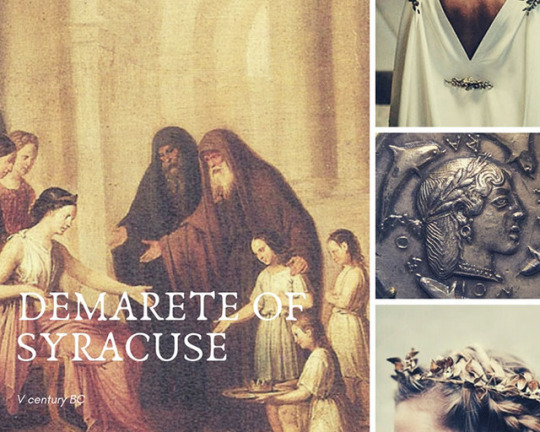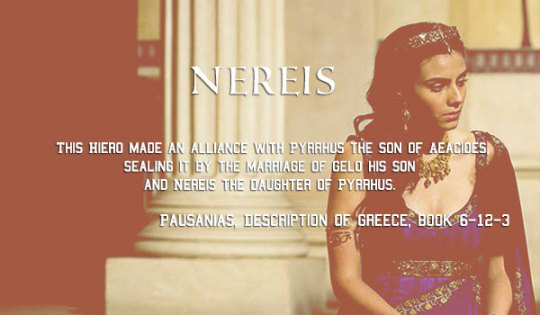#demarete of syracuse
Explore tagged Tumblr posts
Text

When Gelon became tyrant of Syracuse (485 BC) the productivity of the Syracusan mint was enormously increased in order to provide a great stock of such coins for the warchest, with en eye to the inevitable struggle for power against Carthage, which came to a head in 480 BC. Gelon’s victory at Himera in 480 is supposed to have occurred on the same day as the defeat of the Persians at Salamis. Whether or not this was so, it was a victory which in the words of the poet Simonides ‘rescued Hellas from the heavy yoke of slavery’, and ensured the safe development of Greek civilization in the west for at least a couple of generations. Perhaps in connection with this victory, there were minted the famous quasi-metallic coins known as the Demareteion. This was a large decadrachm or ten-drachma piece, similar in essentials to the ordinary coins of quite extraordinary quality. On the obverse there are the slim lean horses and eager charioteer; below them, in separate panel, a running lion which, it was formerly thought, symbolyzed Carthage in defeat, but whose precise significance is somewhat still elusive. In a similar position on a later tetradachm, there is shown a sea-monster or ketos which may allude to the Syracusan victory over the Etruscans off Kymai. On the reverse of the Demareteion, the head of Arethusa is crowned with laurel wreath to signify victory. Firm and precise in modelling, there is almost and ethereal delicacy of touch which extends to details such as the eye and the pendant necklace. The dolphins go clockwise round the head but the descriptions runs the other way. Here beyond doubt a great and sensitive artist bas able to use the accepted forms of the Syracusan coin to create a masterpiece, the surviving specimens of which are extremely few. The splendid preservation of the British Museum’s example enables us to appreciate its quality to the full. The name of the coin, the Demareteion, is taken from that of Demarete, Gelon’s wife. Our sources relate that she interceded with Gelon to moderate the terms imposed on the Carthaginians vanquished at Himera in 480 BC, and that their envoys in gratitude presented Demarete with a golden crown; and that subsequently she had made coins each worth fifty litrai, that is ten drachmai. The coins in question were identified as such by the Duc de Luynes early in the nineteenth century and his theory has generally been accepted. Recently, however, it has been argued from circumstancial evidence that we should reject this tradition and place the coins ten years or more later, which would of course change their historical significance. The controversy continues, but it is difficult simply to reject the tradition outright. Whether or not the date can be fixed accurately, the so-called Demareteion, forms a notable landmark in Syracusan art. the lovely head was not of course in any way intended to be a portrait of Demarete, though it does give a vivid impression of an individual model, meditative yet hinting at reserves of strong personality. Although Gelon and the other Sicilian tyrants of this time were virtually kings, neither their names nor portraits ever appear on the coins; indeed, portraits occur on coins sporadically only from the end of the fifth century and regularly only after the time of Alexander the Great.
Jenkins, G. K. Coins of Greek Sicily, p. 20-21
#history#historicwomendaily#historical women#archaeology#numismatics#demarete of syracuse#greek sicily#people of sicily#women of sicily
6 notes
·
View notes
Photo

For when the ambassadors who had been dispatched from Carthage came to him [Gelon I of Syracuse] begged him with tears to treat them humanely, he granted them peace, exacting of them the expense he had incurred for the war, two thousand talents of silver, and requiring them further to build two temples in which they should place copies of the treaty. The Carthaginians, having unexpectedly gained their deliverance, not only agreed to all this but also promised to give in addition a gold crown to Damarete, the wife of Gelon. For Damarete at their request had contributed the greatest aid toward the conclusion of the peace, and when she had received the crown of one hundred gold talents from them, she struck a coin which was called from her a Damareteion.
Diodorus Siculus, The Library of History, book 11, 26
Demàrete (or Damàrete) was a V century BC Siceliot princess daughter of Theron, tyrant of Akragas (modern-day Agrigento). In order to get a powerful ally, Theron gave his daughter in marriage to Gelon, previously ruler of Gela (491 BC -485 BC) and starting 485 BC first tyrant of Syracuse. At the same time Theron married the daughter of Gelon’s younger brother, Polyzelus. According to the tradition, Demàrete had been started to the mysteries of Demeter of Kore in her youth. This means she was fluent in Greek and had a pure soul, blameless of any crime, as these were fundamental conditions for joining. The cult of Demeter and Kore was especially supported by the Siceliot ruling class as a way to integrate with the natives and obtain their consensus, as the two goddesses were in fact particularly loved by the locals. Moreover Herodotus states that the members of Gelon’s family (the Deinomenid) were ministering priests of the goddesses of the nether world.
Despite that very little is known about Demàrete’s life, her figure is linked to an extremely important event. In 480 BC a combined force led by Demàrete’s father and husband defeated the Carthaginian troops of Hamilcar the Magonid near Himera (in the area of modern-day Buonfornello, province of Palermo). The defeated Punics, deprived of a leader (Hamilcar died during the fight), begged for the victors’ magnanimity. Demàrete then interceded with her husband and obtained a clement treatment for the defeated. Her only request was the Carthaginians would have to stop sacrificing their children to the gods Baal and Tanit. Satisfied with the benevolent terms, the gratefully Punics donated to Demàrete a golden crown worthy of 100 talents as thanks to her mediation. To share the gift with her people, the noblewoman ordered to melt the crown and use the gold to mint a new coin, the demaréteion. This dekádrachmos (worthy of 10 drachms) is one of the few coins mentioned by ancient sources.
In 478 BC, two years after the battle of Himera, Gelon I died. He was succeeded by his brother Hiero I. His wife (whom Gelon had left his inheritance) and young unknown son were put into care of his other brother, Polyzelus, who will marry Demàrete. The couple was soon forced to leave Syracuse and took refuge at the court of the woman’s father, Theron. The new tyrant of Syracuse, Hiero I, didn’t in fact appreciate his brother’s influence over his people (increased after his marriage with Gelon’s widow). The war between Theron and Hiero to restore Polyzelus’ power was avoided thanks to the mediation of the poet Simonides. Followed the reconciliation between the two brothers and Polyzelus and Demàrete were finally able to return to Syracuse and restored to all their former honours. It is unknown when Demàrete died. As for Polyzelus he must have died before Hiero I since it was the youngest Deinomenid brother, Thrasybulus, to become the tyrant after Hiero’s death. Thrasybulus had convinced Gelon and Demàrete’s son to give up his claims over Syracuse. He would be overthrown by his own relatives after a couple of months and forced to go into exile to Epizephyrian Locris (near modern Capo Zefirio, southern Calabria). A democracy was established in Syracuse.
In 396 BC the Carthaginian general Himilco, at war with Syracusan tyrant Dionysius I, put the city under siege. He proceeded to raid the area called Akradina, which was situated outside the city’s walls. His troops destroyed the sanctuary of Demeter and Kore, built by Gelon I after the victory in Himera. Moreover they desecrated many burials and, among them, the ones of Gelon and Demàrete.
Even after death, the memory of Gelon and Demàrete would be dearly preserved. Hiero II, tyrant of Syracuse from 270 BC to 215 BC, will name two of his three children Gelon and Demàrete (the third being another daughter, Heraclea). It was an attempt to reconnect himself to Gelon I, from whom he declared to descend.
#women#history#women history#historical women#sicily#demarete of syracuse#gelon i of syracuse#theron of akragas#hiero i of syracuse#polyzelus of syracuse#thrasybulus of syracuse#dionysius i of syracuse#hiero ii of syracuse#himilco#greek sicily#siracusa#province of siracusa#myedit#historyedit#people of sicily#women of sicily
17 notes
·
View notes
Text

#archaeology#numismatics#sicily#italy#Siracusa#greek sicily#province of siracusa#demarete of syracuse
1 note
·
View note
Photo





"For what," he [the praetor Sopater] asked, "could a boy like Hieronymus, who was hardly in his teens, have done on his own initiative? His guardians and masters reigned unmolested because the odium fell on another; they ought to have perished before Hieronymus or at all events when he did. [...] But it was really the wives who were responsible and who, being of royal blood, had filled their husbands with a passion for royalty, for one of the men had married Hiero's daughter, the other a daughter of Gelo." At these words shouts rose from the whole assembly declaring that neither of these women ought to live, and that no single member of the royal family ought to survive.
Livy, History of Rome, book 24-24
The Women of the House of Hiero II of Syracuse (3rd century BC)
Philistis was the daughter of an influential Syracusan citizen, Leptines. Through her father, she descended from Siceliot historian Philistus. Around 275 BC Philistis married Hiero, who will become tyrant of Syracuse in 270 BC. This man was the illegitimate son of a Syracusan nobleman, Hierocles. Hiero served under Pyrrhus I of Epirus during the Sicilian campaign, and after the King of Epirus left the Island, Hiero was appointed arcontes together with another man, Artemidorus. While the latter, at some point, simply disappeared from the chronicles, Hiero managed to establish a personal rule resembling the contemporary Hellenistic reigns. Philistis would give birth to three children: Gelo, Demarata and Heraclia. Nothing more is known about her life or death, although she’s portrayed in various coins minted during the reign of her husband. In these coins Philistis appears veiled and with idealized traits, resembling the type of Demeter, but also in the style of the coins of the Ptolemaic queens of Egypt.
Demarata was daughter of Hiero II and Philistis. Her name was chosen to honor late queen Demarete of Syracuse and in an attempt to link Hiero’s dinasty to previous tyrant Gelon’s, from whom Hiero declared to descend. Demarata married Adranodoros, one of Hieronymus’ fifteen guardians and part of the pro-Carthaginian faction. Hieronymus was Hiero’s grandson and heir as well as Demarata’s nephew and became Syracuse’s tyrant after his grandfather’s death in 215 BC. Taking advantage of his nephew’s young age (he was 15 at that time), Adranodoros concluded an alliance between Syracuse and Carthage, thus betraying Rome. Moreover he dismissed the other guardians and became Hieronymus’ sole ward with the title of chief counsellor. Hieronymus was killed (stabbed to death) in 214 BC in Leontini by a band of conspirators led by the Syracusan Deinomenes. He had ruled for just 13 months. At first, Adranodoros attempted to seize the power and become the new tyrant. When he understood it was too difficult and risky, he surrendered the power to the Syracusan people and was appointed general. But soon the people became wary of Adranodoros, especially after Ariston, a comedian and friend of the general, declared that Adranodoros and Themistos (brother-in-law of the late Hieronymus) were plotting to massacre the other influential citizens to establish their personal tiranny. Syracusan senate then gave order to eliminate the threat and so Adronodoros and Themistus were killed as soon as they entered the Senate building in 214 BC. Not satisfied with just those two murders and with the intent to justify his decision, the other general Sopater (member of the pro-Roman faction) accused the two men’s wives. In particular, Demarata was depicted as ambitious and power-hungry. She was accused of being the real mastermind behind the idea to remove Hieronymus’ other guardians, as a matter of fact starting Adranodoros’ scramble for power. Demarata’s supposed (or not) aspiration to become Syracuse’s queen was shattered the moment she was killed by the angry mob incited by Sopater’s accusations.
Heraclia was daughter of Hiero II and Philistis, as well as sister of Demarata and Gelo. She married Zoippus, who together with Adranoros was one of his nephew Hieronymus’ guardians. Like his brother-in-law, Zoippus was part of the pro-Carthaginian faction and worked to distance Syracuse from Rome. He was sent to a diplomatic mission to Ptolemy (most certainly Ptolemy IV Philopator). When in 214 BC Zoippus was reached by the news of Hieronymus’ death, he decided to remain in Alexandria in a self-imposed exile and so he survived his family’s massacre. His wife, Heraclia, and his two unnamed daughters weren’t equally lucky. No importance was given to the fact they were extraneous of plots and political schemes, what mattered was they were members of the royal family. They seeked refuge in a temple, hoping the mob would have respected the sacrality of the place. Heraclia implored the crowd to at least spare the girls, who were so young and innocent and just kill her. She was dragged outside the temple and killed before her daughters’ eyes with her blood splattering them. The girls, at first, managed to resist, but in the end they fell lifeless to the ground with their bodies full of wounds and whole place was covered in their blood. Soon after a messenger arrived with the order they were not to be killed, but it was already too late.
Nereis was an Epirote princess and the daughter of Pyrrhus II of Epirus and an unnamed woman. Her sister Deidameia was the last Aeacid sovereign of Epirus. Nereis descended from both Pyrrhus I of Epirus (her great-grandfather) and the Syracusan tyrant Agathocles (her great-great-grandfather). Her marriage to Gelo, Hiero’s son, was part of her father-in-law’s policy to strenghten and validate his dynasty. A similar alliance had been established in the past, and Nereis was the result of it. The marriage pact was concluded just before the fall of the Aeacid dynasty. The princess bore at least two children to Gelo, a girl and a boy: Harmonia and Hieronymus. Nothing is known about her fate, but it’s implied she survived her sister, making Nereis the last surviving Aeacid royal member.
Harmonia was the only daughter of Gelo of Syracuse and Nereis of Epirus. This made her the granddaughter and then the sister of the last two Syracusan tyrants. She married Themistos, member of the pro-Carthaginian faction and possibly one of the 15 guardians of Hieronymus. Themistos was accused together with Adranodoros to aspire to a personal tyranny following the murder of his brother-in-law and then killed. Like her aunt Demarata, Harmonia was considered a schemer and a puppetmaster of both her husband and young brother. After the murders of her aunts and cousins, it was only a matter of time Harmonia would have followed them. Her nurse then found a girl of the same age and resembling her protegée. The girl accepted to pass off the princess and was dressed in royal attire by the nurse, then she proceded to draw all the attention to her. In the meantime, Harmonia went hiding, but seeing the murderous crowd killing the innocent girl was too much for the princess. Tradition says she killed herself, although according to Valerius Maximus she revealed herself in front of the killers, claiming to be the real Harmonia, and was instantly murdered.
#women#history#women history#historical women#sicily#Philistis#Demarata#Heraclia#Nereis#Harmonia#hiero ii of syracuse#hieronymus of syracuse#greek sicily#people of sicily#women of sicily#siracusa#province of siracusa#historyedit#myedit
64 notes
·
View notes